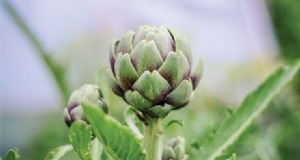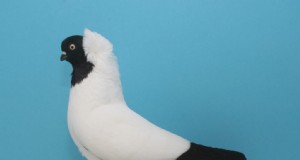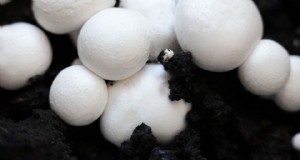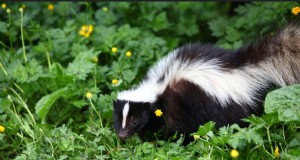A Saya R - B reating F adalah H C ultu ulang
Murrel dan ikan lele dikenal karena harga dirinya dan permintaan pasar yang baik karena kandungan lemaknya yang rendah dan sedikit duri intramuskular. Ikan yang bernapas di udara kuat dan mampu menghirup udara atmosfer dengan organ pernapasan aksesorinya. Dengan adanya alat bantu pernafasan ini ikan dapat bertahan hidup selama beberapa jam di luar air. Organ pernapasan aksesori ini adalah pohon pernapasan di Clarias , organ labirin di Channa , kandung kemih udara di Heteropneuste , ruang branchial pada ikan di atas, dll dan mampu menelan udara. Ini dapat dibudidayakan di daerah oksigen terlarut rendah seperti air kotor dangkal, kolam dan rawa-rawa yang terlantar. Karena kemampuannya untuk hidup di luar air, budaya mereka melibatkan risiko rendah dan manajemen sederhana.
Di India, Andhra Pradesh, Assam, Uttar pradesh, Madhya Pradesh, Tamilnadu, Karnataka, Maharastra, Bihar dan Meghalaya mendukung perikanan alami yang paling signifikan dari ikan bernapas udara. Ikan-ikan ini bersifat karnivora dan mereka mengadopsi dengan sangat baik untuk makanan tambahan. Karena tidak banyak pemborosan energi melalui respirasi oleh pernapasan udara yang tumbuh di perairan dangkal, hasil yang baik dapat diharapkan.
Spesies ikan bernafas udara yang dapat dibudidayakan adalah Gambar 9.1
C H A nn A S T R A dia kamu s – Ikan murrel atau kepala ular besar atau belang
C hann A tanda baca s – Murrel berbintik
Channa marulius – Murrel raksasa
Clarias batrachus – Magur
Heteropneuste fosilis – Singhi
Anabas testudinus – Koi atau panjat tebing.
Dari ini Channa striatus memiliki permintaan tertinggi di pasar dan juga memerintahkan harga yang lebih tinggi. Terbaik berikutnya adalah Clarias dan Heteropneuste . Budaya spesies di atas menguntungkan.
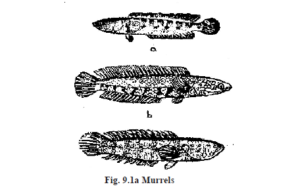
a) Channa marulius b) Channa straitus c) Channa punctatus
Cu aku turab aku e daerah S
Budidaya ikan penghirup udara membutuhkan perairan dangkal dengan kedalaman 50 – 75 cm. Kolam untuk budidaya ikan air-breathing tidak perlu dibuahi dengan bahan kimia. Ikan bernapas udara juga dapat dibudidayakan di keramba di sistem air mengalir seperti sungai, kanal dan perairan yang tidak dapat dikelola seperti waduk. Budidaya ikan yang bernafas di udara sama-sama dapat beradaptasi di perairan yang tidak cocok untuk spesies ikan mas yang dapat dibudidayakan secara konvensional serta di kolam budidaya ikan mas. Kolam dangkal berguna untuk ikan, di mana ikan harus menghabiskan lebih sedikit energi dalam perjalanan ke permukaan untuk asupan oksigen atmosfer.
Lihat D koleksi n
Benih murrel, magur dan singhi dikumpulkan dari sumber daya alam, terlepas dari keberhasilan yang dicapai dalam pemuliaan yang diinduksi. Bahkan hari ini, benih yang dikumpulkan dari alam terus menjadi sumber bahan yang paling dapat diandalkan untuk penebaran. Murrel mencapai kedewasaan dalam dua tahun diketahui berkembang biak sepanjang tahun. Benih 2-4 cm dapat dikumpulkan sepanjang tahun dan dari parit tadah hujan dan badan air dangkal dengan gulma yang melimpah. Namun puncak pemijahan diketahui terjadi sebelum musim hujan.
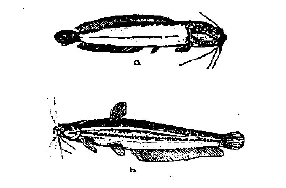
a) Clarias batrachus b) Heteropneustes fossilis
Anak-anak muda yang muncul dari telur bergerak dalam kawanan dan pengumpulannya dalam jumlah besar selalu mudah. Bibit mungkin tidak cenderung bergerak dalam kawanan. Benih murrel raksasa dapat diidentifikasi dari tubuh abu-abu gelap dan pita kuning oranye lateral dari mata hingga sirip ekor. Benih murrel belang memiliki tubuh merah cerah dengan pita emas kemerahan dan pita hitam gelap dari mata hingga sirip ekor. Goreng murrel tutul dapat dikenali dari tubuhnya yang berwarna coklat tua dengan pita lateral kuning keemasan dan garis kuning tengah punggung di bagian belakang.
Dalam budaya murrel, lebih baik menyimpan benih daripada menggoreng. Kanibalisme ditemukan pada benih ikan murrel. Tingkat kelangsungan hidup benih yang dihasilkan oleh pemuliaan yang diinduksi akan buruk dan untuk mempertahankan pemijahan dan menumbuhkannya ke tahap benih sulit. Pemijahan tidak makan apa pun selama dua hari setelah kemunculannya dari telur. Karenanya, benih harus dilatih untuk menerima makanan tambahan di kolam terpisah. Pakan tambahan terdiri dari telur rebus, kepompong ulat sutra, cincang ikan sampah dan cacing bersama dengan ragi dan vitamin B.
Ini diberikan selama sekitar 15 hari pada tingkat 20% dari total berat badan mereka. Benih mencapai tahap fingerling dengan panjang 4-6 cm dalam waktu satu bulan.
Ikan lele berkembang biak dua kali dalam setahun dengan puncak musim kawin pada musim hujan. Bibit Magur dapat diidentifikasi dengan sirip punggung yang lebih panjang dan warna batu tulis. Bibit Singhi memiliki sirip punggung yang pendek dan berwarna merah muda. Benih koi dapat dikenali dari bintik hitam pada pangkal ekor dan rona kehijauan pada permukaan punggung tubuh. Magur membuat lubang sedalam 25 cm di pematang di bawah permukaan air. Telur yang dibuahi menempel pada rumput dan dijaga oleh pejantan. 2, 000 – 15, 000 benih dapat dikumpulkan dari setiap lubang dengan bantuan jaring tangan kecil dan dipelihara di pembibitan sampai mencapai tahap fingerling dengan panjang sekitar 5 cm.
Magur dapat dibudidayakan di kolam untuk produksi benih. Sekat kawat berukuran 1 X 1 m dibuat di pinggir pematang. Di tengah setiap kompartemen, lubang berdiameter 30 cm digali dan dilengkapi dengan beberapa tanaman air. Setelah melepaskan kedua jenis kelamin, sekitar 5, 000 benih dapat dikumpulkan dari setiap kompartemen dalam waktu 10 hari. Jantan dan betina juga dapat dipelihara di kolam tanah kecil. Mereka dapat diisi 20, 000 / kolam dan diberi makan dengan zooplankton yang disaring atau tepung ikan cincang dan bungkil kacang tanah. Benih dapat dipelihara selama 15 hari di persemaian.
Musim puncak pengumpulan benih singhi adalah periode pra-musim dingin ketika padi dipanen dan dataran rendah terbuka.
Lihat D tr A nspor T
Benih atau benih ikan yang bernafas udara dapat diangkut tanpa kemasan oksigen. Drum plastik atau drum besi digunakan untuk mengangkut benih atau benih. Pembawa harus memiliki cukup ruang untuk permukaan biasa mereka untuk menghirup udara atmosfer. Pembawa harus memiliki sejumlah kecil gulma air seperti Vallisneria, hidril , Myriophyllum dan Ceratophyllum . Gulma dapat membantu untuk menghindari melompat dari ikan selama transportasi. Jika jaraknya lebih jauh, lebih baik untuk mengangkut mereka dalam wadah plastik oksigen dikemas.
Pon D ibu n umur n T
Pembibitan sekitar 10 – 15 m2, memiliki kolom air 50 cm. Ini ditebar dengan 0,2 – 1,5 juta benih / ha. Sebelum ditebar, pemupukan dilakukan dengan kotoran sapi mentah sebanyak 500 Kg/ha saja. Emulsi sabun – minyak untuk membasmi serangga dioleskan ke air pembibitan. Benih dan benih magur dan singhi yang dikumpulkan dari sumber daya alam memerlukan pengelolaan pembibitan, tetapi murrel harus dilatih di kolam pembibitan sebelum ditebar. Setelah pengelolaan pembibitan, bibit akan dipindahkan ke kolam penebaran.
stok k di dalam G
Bibit berukuran seragam dipilih untuk ditebar. Benih didesinfeksi dengan larutan KMNO4 2% selama 5 menit atau dicelupkan ke dalam larutan formalin 200 ppm selama 50 detik sebelum ditebar. Bibit yang terluka dirawat dengan 0,3% acriflavine selama 5 menit.
Ikan-ikan ini dapat melarikan diri melalui memanjat atau menggali. Karenanya, pematang kolam harus kokoh dengan balok kayu atau kayu berat, atau dipagari dengan rotan bambu atau kawat kasa hingga ketinggian sekitar 50 cm.
Lebih banyak benih dapat ditebar dalam sistem budaya mereka. 40, 000- 60, 000 sistem.
benih/ha ikan lele dapat ditebar secara monokultur Dalam sistem polikultur 20, 000 – 30, 000 bibit/ha kucing
ikan dapat ditebar. Dalam sistem monokultur, 15, 000 bibit/ha murrel raksasa, 20, 000/ha untuk murrel belang dan 20, 000 – 30, 000 / ha dalam hal tebar murrelare tutul. Dalam sistem polikultur, murrel bergaris dan berbintik dapat ditebar pada tingkat 20, 000 bibit/ha dengan perbandingan 1:1.
Polikultur murrel – gurame dan lele – gurami juga dapat dilakukan dengan perawatan dan pengelolaan yang tepat. Benih ikan yang bernafas udara harus ditebar hanya ketika ikan mas telah tumbuh minimal 300 gr, sehingga ikan yang menghirup udara tidak memangsa ikan mas. Dengan ini, tidak hanya penghasilan tambahan yang bisa didapatkan melalui hasil tangkapan ikan udara, tetapi juga pertumbuhan ikan mas dapat ditingkatkan. Nanti mungkin, sebagai ikan rucah yang mungkin bersaing dengan ikan mas untuk mendapatkan makanan dan ruang, diberantas oleh nafas udara yang tumbuh.
makan G
Untuk mempertahankan pasokan makanan yang melimpah untuk pertumbuhan pernapasan udara, kolam penebaran harus kaya akan sumber makanan hewani seperti berudu katak dan ikan rucah. Jika sumber makanan ini tidak mencukupi, nila juga dapat ditanam di kolam murrel dan cat fish. Ikan rucah laut kering juga digunakan dalam budidaya ikan dan lebih ekonomis. Pakan dapat diberikan pada ikan lele dengan sisa jeroan ikan atau limbah rumah potong atau pupa ulat sutera kering yang dicampur dedak padi dan bungkil dengan perbandingan 1 :1 :1 :1. Campuran bungkil, dedak padi dan bubur biogas dengan perbandingan 1 :1 :1 telah berhasil menyediakan pakan berbiaya rendah untuk singhi. Dedak padi dan pakan unggas dalam 3 :1 dan bubur biogas dan dedak padi dalam 1 :2 juga diberikan dengan takaran 5 – 8% dari berat badan.
Selama delapan bulan budidaya semi intensif di kolam tergenang, Stok ikan lele yang bernafas dapat diberi makan pada tingkat berikut setiap hari selama jam-jam gelap untuk mendapatkan pemanfaatan pakan yang lebih baik (Tabel 9.1).
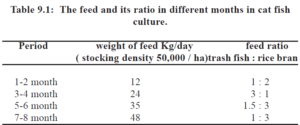
Pakan dapat disebarkan di kolam dalam jumlah kecil dari pematang atau dapat disajikan dalam keranjang pakan yang diturunkan di dekat tepian sebagai tambahan untuk menyebarkan pakan untuk memastikan ketersediaan pakan bagi semua ikan di kolam. Perangkap lampu dapat dipasang di kolam murrel, dimana serangga dapat tertarik oleh cahaya dan dimanfaatkan oleh murrel sebagai makanan kaya protein.
Bibit ikan murrel yang terlatih juga akan menerima ikan rucah laut kering murah yang direndam dalam air, yang dapat diberikan sesuai dengan jadwal makan berikut (Tabel 9.2). Limbah rumah potong hewan dan pupa ulat sutera sebagai sumber protein hewani juga dapat dimanfaatkan.
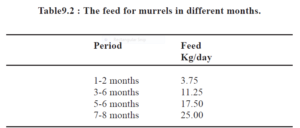
gr Hai wt H A n D P R od kamu ct Saya Hai n
Ikan murrel dan ikan lele mencapai ukuran yang dapat dipasarkan dalam jangka waktu masing-masing bulan. Jika praktik manajemen tepat, murrel raksasa dan belang dapat mencapai pertumbuhan 1 – 2 Kg/tahun. dan 0,75 Kg/tahun. masing-masing, sedangkan murrel tutul tumbuh hingga 160 gr. dalam 8 bulan. Ikan kucing dikenal tumbuh lambat jika dibandingkan dengan ikan murrel. Magur dan singhi masing-masing tumbuh menjadi 0,2 Kg dan 0,1 Kg. Tingkat konversi dengan pakan yang direkomendasikan adalah sekitar 2 :1.
Ikan murrel dengan pakan ikan sebagai pakan tambahan menghasilkan sekitar 4 ton/ha/tahun. Magur dengan pakan tambahan berupa ikan rucah kering dan bekatul, memberikan produksi 10 ton/ha/tahun. Singhi memberikan hasil 4,4 /ton/ha/tahun. Polikultur murrel dan koi, diberi makan dedak padi, kue minyak mustar dan ikan rucah, memberikan produksi 11,8 ton/ha/tahun, sedangkan magsur dan singhi yang diberi dedak padi dan ikan rucah memberikan hasil 5 ton/ha/tahun. Budidaya campuran 3 spesies murrel menghasilkan 4 ton/ha/thn bila diberi pakan ikan rucah laut yang direndam dan dikeringkan serta pupa ulat sutera segar sebagai makanannya . Pada budidaya intensif magur dapat memberikan 7 ton/ha/5 bulan.
C ul T kamu e w Saya T H ca R P S
Dengan padat tebar 5000/ha ikan mas India dan Cina dan 1000 bibit magur menghasilkan 2518 Kg/ha/thn ikan gurame dan 3711 Kg/ha/thn magur. Hal ini menunjukkan bahwa polikultur lebih menguntungkan, dan sangat berguna untuk memasukkan magur ke dalam sistem budidaya ikan mas. Dengan padat tebar 20, 000/ha magur beserta sisa gurame (setelah panen sebagian gurame) diperoleh produksi 3,96 ton/ha/thn dengan perbandingan dedak padi 50 :30 :17 :3, makanan ikan, bungkil kacang tanah dan mineral sebagai pakan tambahan. Magur ditemukan cocok untuk budidaya ikan mas komposit menggantikan ikan mas biasa. Magur, koi dan singhi juga cocok untuk budidaya bersama dengan ikan mas makhana yang sangat berharga, euryale ferox .
Har v estin G
Musim panas sangat ideal untuk memanen ikan yang menghirup udara dari kolam. Kolam dikeringkan dan ikan dipanen dengan bantuan jaring gayung atau jaring tangan. Karena tingginya permintaan dan harga pasar, budidaya udara ini memberikan pendapatan yang menguntungkan bagi pembudidaya ikan dengan teknik pengelolaan yang sederhana.
C A G e kultus kamu R e
Udara-nafas dapat dibudidayakan di kandang juga. Kandang disiapkan dengan tikar yang terbuat dari bambu yang dibelah di air yang mengalir. Luas kandang yang optimal berukuran 2m X 1m X 1m. Bagian atas keramba setengah ditutup dengan tikar dan bagian yang tidak tertutup ditutup dengan jaring untuk memudahkan pemberian makan dan untuk mencegah keluarnya ikan. Jaring serat sintetis juga digunakan untuk menyiapkan kandang.
Magur ditebar dengan harga 200/kandang, diberi pakan 10% dari berat badan pada ikan rucah kering, oil cake dan dedak padi dan menghasilkan 10 – 12 Kg/m3/thn. Singhi menghasilkan 12-20 Kg/m3/thn dengan padat tebar 100 – 150/kandang dan 10% dari bobot badan pakan pupa ulat sutera, dedak beras dan kue minyak mustard. Koi menghasilkan 4,2 Kg/m3/thn dengan tingkat tebar 50 – 100/kandang dengan pakan yang sama dengan singhi. Ikan murrel tutul menghasilkan 4 Kg/m3/thn dengan ikan rucah dan dedak padi. Karenanya, budidaya ikan bernapas udara sangat menguntungkan, serta kaya akan sumber protein hewani. Ikan ini dianggap sebagai kelezatan, dan memerintahkan harga yang sangat tinggi dan permintaan terus menerus di pasar.
T R OU T CU L T UR E
Ikan trout ditanam sebagai ikan makanan atau ikan olahraga, dilepaskan ke perairan alami untuk olahraga nelayan. Ikan trout populer karena menarik, ikan aduan aktif dan menyediakan daging berkualitas sangat tinggi. Trout telah dilepaskan dan dibudidayakan di air di seluruh dunia. Trout telah tumbuh dalam skala komersial di Amerika Serikat sejak waktu yang sangat lama. Budayanya di Eropa sudah ada sejak 400 tahun yang lalu. Ini adalah ikan air dingin. Ini terutama mendiami sungai, aliran, anak sungai, danau dan kolam. Di India ditemukan di Kashmir, Himachal Pradesh, Uttar Pradesh, Nilgiris, Perbukitan Kodai dan pegunungan Munnar.
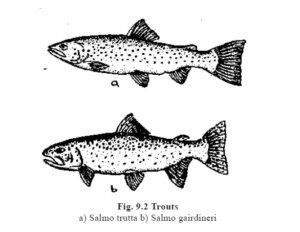
Banyak spesies ikan trout ditanam, tapi tiga yang paling umum adalah ikan trout pelangi, Slamo gardneri atau Oncorynchus ciumanku, ikan trout coklat Eropa, S.trutta (Gbr. 9.2) dan trout sungai, Salvelinus ubun-ubun. Ikan trout memiliki tubuh yang ramping, bukaan insang yang sempit dan insang yang mengecil. Ikan trout disesuaikan dengan perairan yang sangat teroksigenasi dan suhu titik beku. Ikan trout memiliki kekuatan penggerak yang besar dengan kebiasaan menempel dan menggali. Mulut dimodifikasi dengan bibir serak untuk pengumpulan makanan dari kerikil, batu, dll..
S P aw n di dalam G
Musim pemijahan S.gairdneri adalah dari bulan September sampai Februari, S.trutta adalah dari Oktober hingga Desember dan S.fontinalis adalah dari Oktober sampai Januari. Trouts lebih memilih substrat kerikil untuk melindungi telur mereka dan telur menempel pada kerikil dan puing-puing. Trout membangun sarang dan bertelur di dasar sungai. Pembudidaya memungkinkan pemupukan buatan, karena pemupukan dasar sungai menghasilkan tingkat penetasan yang lebih rendah daripada pemupukan buatan. Manipulasi fotoperiode dan suhu air dapat digunakan untuk menginduksi pematangan gonad, sehingga ikan muda dihasilkan sepanjang tahun. Ikan trout ditangkap pada saat atau hampir dewasa saat mereka berenang di hulu dan dibesarkan di kolam ro dewasa. Induk ikan ditempatkan di kolam kecil dengan air mengalir dan sering ditutup dengan jaring untuk mencegah mereka melompat. Air susu dari seekor jantan dapat digunakan untuk membuahi dua betina, sehingga lebih banyak betina ditebar dengan sedikit jantan.
Ikan trout menunjukkan dimorfisme seksual. Jantan menjadi lebih berwarna cerah dan rahang bawah mengembangkan paruh bengkok selama musim kawin. Betina mengembangkan perut diperpanjang dan papila genital menjadi lebih besar dan kemerahan. Ketika mereka benar-benar matang, susu atau telur keluar dengan sedikit tekanan pada lubang perut. Saat ikan trout sudah matang, ikan betina ditelanjangi dan telurnya dikumpulkan dalam enamel berwarna hitam atau wadah plastik di mana susu jantan ditambahkan dan dicampur secara menyeluruh dengan bulu ayam untuk pembuahan. Air ditambahkan setelah pencampuran dan air menyebabkan telur membengkak. Air tidak boleh ditambahkan sebelum pencampuran, karena motilitas sperma sangat berkurang dengan adanya air. Untuk memastikan tingkat kelangsungan hidup yang lebih baik, telur dapat dikumpulkan dalam sejumlah kecil larutan garam (10 liter air tawar +90 gr garam biasa + 2 gr kalium klorida + 3 gr kalsium klorida). Telur yang dibuahi mengembangkan semburat hijau dan dikenal sebagai 'hijau', yang kemudian dipindahkan ke hatchery. Sebelum mentransfer menghapus partikel asing dan telur mati.
T ra n P Hai R T pada Saya Hai n Hai F T mengusir e gg S
Telur ikan trout yang telah dibuahi dan mengeras (dikeraskan selama 24 jam) diangkut dalam karton karton ukuran 20 X 30 X 20 cm. Sisi dalam kotak papan kartu dilapisi dengan lapisan styrofoam. Dua spons lembab atau kapas diatur, satu di sisi bawah dan lainnya di sisi atas. Kantong polietilen berpori berisi sekitar 4, 000 telur ditempatkan di antara spons basah dan kapas. Kantong polietilen dengan es pecah IKg disimpan untuk menjaga suhu rendah, di atas bantalan atas. Karton karton ini diangkut ke berbagai tempat.
Induk ayam kamu teknologi H unik S
Telur ikan trout diinkubasi dengan menyimpannya dalam bak beton dengan nampan datar dan tersusun horizontal, inkubator atau toples. Tempat pembenihan harus dilengkapi dengan sirkulasi air tawar yang disaring dan bebas lumpur. Di masa lalu keranjang digunakan untuk inkubasi. Inkubator aliran vertikal adalah yang paling umum. Ini memiliki banyak stainless steel, dari fiberglass, aluminium, atau kayu, atau PVC, atau nampan plastik, disusun satu di atas yang lain. Bagian bawah baki dilengkapi dengan lembaran seng berlubang, pemanggang kaca atau kain jala untuk memastikan aliran air melalui baki yang berbeda. Ukurannya dapat bervariasi dari 180 X 30 X 10 cm hingga 500 X 100 X 50 cm. Setiap baki memiliki keranjang telur atas dan kompartemen berlubang bawah tempat keranjang diletakkan. Telur ditempatkan di keranjang untuk inkubasi. Air dimasukkan ke baki sedemikian rupa sehingga mengalir melalui keranjang berisi telur, kemudian turun ke baki di bawah dan naik melalui keranjang itu dan seterusnya melalui inkubator. Aliran air ke atas melalui telur memungkinkan peningkatan aerasi dan memfasilitasi pembuangan metabolit.
Guci penetasan juga digunakan untuk inkubasi telur ikan trout. Ini terdiri dari layar galvanis mesh 0,5 mm dengan lapisan kerikil di bagian bawah, tepat di atas saluran masuk. Tempat tidur kerikil ini berguna sebagai filter untuk menghilangkan partikel yang tidak diinginkan. Telur ditempatkan di atas filter untuk menetas. Air melewati saluran masuk, upwells melalui filter dan telur dan mengalir melalui outlet. Setelah menetas, tukik dipelihara selama beberapa waktu di dalam toples.
Telur sangat sensitif selama periode penetasan. Telur yang baru dibuahi bisa mati jika langsung terkena sinar matahari. Selama inkubasi, air harus bergerak dan memiliki kandungan oksigen yang tinggi. Inkubasi biasanya berlangsung di air dengan suhu 8°-12°c. Benih dapat disimpan di nampan sampai mereka menjadi aktif dan dapat mulai makan. Mereka dapat dilepaskan untuk ditebar di perairan alami.
Cu aku tu ulang Hai F T rou T S
Benih dipelihara dalam bak pemeliharaan kecil sebelum benar-benar menyerap kantung kuning telurnya, dan perkenalkan untuk hidup dengan pakan buatan. Kemudian dipindahkan ke kolam pembibitan untuk dipelihara hingga tahap benih lanjutan. Kolam pembibitan dapat berupa beton atau berdinding batu dengan ukuran 2,5 X 1 X 0,75 m sampai 9 X 1 X 0,75 m. Aliran air dapat dipertahankan 100 liter/menit. di dalam kolam pembibitan.
Benih tingkat lanjut dipelihara hingga dewasa di kolam pemeliharaan dan raceways. Kolam pemeliharaan adalah badan air alami, dan raceway hanyalah kolam ikan air mengalir. Ukuran raceways harus berkisar antara 20 -100 m2 dengan kedalaman 1,5 m. Serangkaian raceways dibangun di kedua sisi sungai atau sungai. Setiap raceway mendapatkan air dari aliran dan air keluar dari raceway melalui outlet yang terdapat di sisi yang berlawanan. Layar pelat seng digunakan di saluran masuk dan keluar. Aliran air dipertahankan 50 liter/detik, ke kolam dari sungai. Kolam melingkar dan oval digunakan di AS. Tingkat penebaran mungkin dibatasi untuk menghasilkan 5-10 Kg/m2. Produksi tinggi 200 Kg/mis juga dimungkinkan di balapan, jika pengelolaannya baik.
Budaya kandang ikan trout juga umum. Dalam sebuah percobaan, benih ditebar 1,4 Kg/m2 di kandang dan diberi makan 3 % dari berat badan mereka setiap hari. Ikan trout ini tumbuh menjadi 27-88 gr. dalam dua bulan. Pakan yang diberikan pada ikan trout antara lain limpa sapi, jantung dan paru-paru dan ikan rucah laut atau air tawar. Banyak pakan ikan trout komersial tersedia di pasaran. Ikan trout diberi makan 3 – 4 kali sehari. Ada beberapa cara pemberian pakan pada ikan trout. Pakan disemprotkan ke permukaan air, atau pakannya bisa disimpan di dalam karung atau di wadah di pojok kolam. Ini digunakan untuk pengumpan permintaan, di mana setiap kali ikan trout menabrak pelatuk, umpan dilepaskan ke air, atau pengumpan otomatis juga dapat digunakan. Guci dan drum juga digunakan untuk membesarkan benih ikan trout.
Se w ag e - Fe D F Saya S H Cu aku tu ulang
Air limbah berawan, cairan kotor dan berbau dari toilet dan dapur rumah kami. Ini memiliki mineral dan nutrisi organik dalam keadaan terlarut atau terdispersi dalam kondisi padat. Pembuangan limbah telah menjadi masalah global karena urbanisasi. Ini adalah efek dari demophora, yaitu pertumbuhan populasi manusia yang tidak berkurang. Dalam beberapa tahun terakhir, limbah telah menjadi polutan utama perairan pedalaman, terutama sungai. Ini adalah sumber dari banyak epidemi. Ini bertanggung jawab atas ancaman serius terhadap ekosistem tanah dan air. Pendekatan terhadap pembuangan air limbah harus memanfaatkan residu ini dengan konsep penggunaan kembali atau daur ulang melalui sistem keseimbangan ekologis yang terutama melibatkan akuakultur. Pemanfaatan limbah cair untuk meningkatkan kesuburan kolam air tawar telah lama dikenal di banyak negara di dunia.
Jumlah limbah yang dihasilkan adalah India dalam 3,6 mm3/hari (juta meter kubik per hari) atau 800 mg/hari (juta galon per hari). Sekitar 30% (1,9 mm3/d) diproduksi di pusat kota. Hanya 1,3 mm3/hari (20,4% dari total satu hari India) yang dirawat di pusat-pusat ini. Hampir 80% dari total satu hari negara masih harus dirawat dan dimanfaatkan. Jumlah kotoran yang diperoleh dari produksi satu hari limbah di India adalah sekitar 0,126 m.ton. Ini sama dengan 46 m.ton/tahun. Kotoran dari kotoran satu hari cukup untuk membudidayakan 0,1 m.hektar tanaman tahunan ikan. Limbah juga berguna untuk membudidayakan ikan. Di India hanya ditemukan lebih dari 130 peternakan ikan yang diberi makan limbah yang meliputi area seluas 12, 000 hektar. Perikanan air limbah Vidyadhari di dekat Calcutta adalah contohnya, di mana para nelayan telah memanfaatkan sepenuhnya sistem pembuangan kotoran di Kalkuta. Di sini hasil ikan sekitar 1, 258 Kg/ha. Kapasitas pupuk yang tinggi dikombinasikan dengan potensi untuk dijadikan sebagai sumber air tambahan untuk budidaya ikan dan meningkatkan produksi ikan.
Bersama M posisi T io n Hai F limbah G e
Komposisi limbah bervariasi dari satu tempat ke tempat lain dan menurut musim. Air merupakan komponen utama dari limbah (99%) dan suspensi padat dalam limbah berjumlah 1% saja. On an average the sewage of Indian towns contains 52 ppm nitrogen, 16 ppm phosphorus, 45 ppm potassium and 350 ppm biodegradable organic matter. The organic carbon component is 25-40 ppm, the ratio of carbon and nitrogen being 1:3. Salts of several heavy metals such as Zn, Ni, Cr, Pb, etc. are also found above the permissible levels in sewage. The organic refuses in the sewage have proteins, carbohydrates and fats in varied proportions depending on the nutritional status and food habits of the population. Among carbohydrates, readily degradable starch, sugar and cellulose are detected.
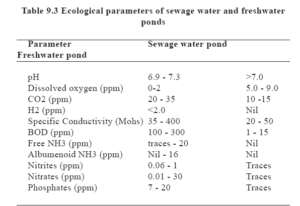
Some ecological features of different waters are mentioned in Table 9.3. Sewage water has high BOD (Biological Oxygen Demand) and Oxygen Consumption (OC) values. Dissolved oxygen becomes depleted in sewage water due to high oxygen demand and low photosynthetic rate. Photosynthesis is low because of poor illumination as the suspended solids in sewage water obstruct sunlight. Rata-rata, strong, medium and weak sewage consist of 1200 ppm, 720 ppm and 350 ppm of total solids respectively, out of which 850 ppm, 500 ppm and 250 ppm occurs in a dissolved state and 350 ppm, 220 ppm and 100 ppm is found in suspended form. Dissolved salts being very high in sewage water, manifest high specific conductivity. Production of acids in high amounts render the water acidic, making the medium unfit for supporting life (Fig. 9.3). Acidity of water below pH4 is known to kill the flora and fauna.
Sewage enriches water with organic matter that begins to decompose aerobically thereby depleting dissolved oxygen and leading to anoxic condition. Anoxia causes non-mortality of animals, adding organic matter further to the already rich organic content. In the absence of dissolved oxygen the organic matter undergoes anaerobic decomposition as a result of which obnoxious gasses like H2S, CH3 and CO are produced. These gasses besides being toxic, react with water to form acids.
Immediate effect of sewage on the biota is eutrophication. Sewage water stimulates rapid growth of phytoplankton leading to an algal bloom followed by rapid increase in zooplankton. For utilizing sewage in aquaculture, the properties such as the concentration of dissolved and suspended solids, karbon organik, nitrogen and BOD are essential.
Micro B iolog Saya ca aku C harac T arist Saya C S
Harmless and even useful non-pathogenic bacteria are present in much greater numbers in domestic sewage as compared to pathogenic bacteria comprising mostly the intestinal microorganisms found in the community producing the waste. Usual load of coliform bacteria in raw sewage ranges between 108 and 109 MPN/100ml.
Si T e S e lect Saya Hai n A n D C onst R ucti Hai n Hai F se w age- F e D fis H jauh M
Fish farm in the vicinity of an urbanized area has the scope to receive domestic sewage for the recycling of nutrients. Any area adjacent to a municipal sewage treatment plant is ideal for the location of a sewage-fed fish farm. The fish farm site should be at a lower level than the treatment plant so that the sewage can easily enter into the pond through a pipeline by gravity. The fish farm should have facilities of draining out water from the ponds.
The plan of the fish farm depends upon the source of the sewage, system of culture and topography of the land. Nearly 75% of the total area is converted into ponds leaving the rest for dykes and other purposes. Rectangular fish ponds of 0.3 to 1 ha are constructed with a slope of 1:3 for the embankment and maximum depth of 1.5m. Each pond should have proper drainage facilities.
The effluent is collected in a sump at the farm, from where the effluent is taken into the ponds through the distributing system. Additional arrangement is made to connect the pipelines with freshwater supply for emergency dilution.
S e wag e tr e atme n T
Sewage treatment is necessary to kill the harmful microbes, prevent anoxia, raise the pH to an alkaline level, increase photosynthesis, reduce organic content, etc. The treatment has to be inexpensive and one which induces in sewage water the conditions prevailing in a natural freshwater pond. Sewage is treated in following three ways – mechanical treatment, chemical treatment and biological treatment.
Mech A nica aku T reatment:
Solids and organic matter are removed to a large extent by mechanical treatment, which involves flowing, dilution and sedimentation. Usually screening and straining of sewage it is done to remove the waste solids. The liquid and semisolid wastes are then
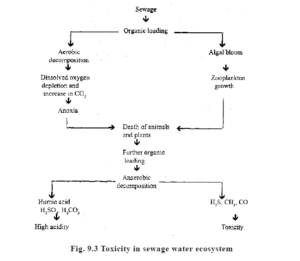
subjected to treatment for the removal of colloidal and semisolid suspension by dilution, H2S, CO2, CO, NH3, CH3 concentrations are brought below the normal levels. Dengan demikian, through primary treatment the supernatent effluent is separated from the sludge.
C H emic A aku T reatment:
In chemical treatment, several dissolved substances, harmful germs and aggressive odours are eliminated. Inexpensive precipitants,
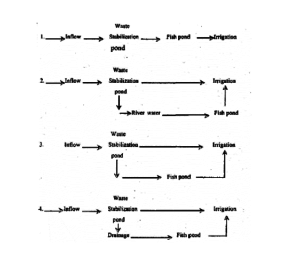
coagulants, chelating substances, disinfectants, deodorising agents, etc. are used in this treatment. The sewage water is also treated with chlorine, bleaching powder and copper sulphate. It is also known as secondary treatment.
Biol Hai gica aku T R e atment :
In biological treatment of sewage care is taken to promote bacterial growth. Bacterial action promotes oxidation of organic matter. The end products nitrogen oxides, bring about rapid growth of algae, particularly the blue green Microcystis. This arrests anoxia of water by raising the dissolved oxygen, lowering the CO2 content and by increasing the pH from acidic to alkaline levels. The algal bloom reduces the concentration of dissolved salts in the sewage water.
Po n D ibu n ag e laki-laki T
F e rtil Saya zati Hai n
Fertilization of sewage-fed pond is done in two phases, pre-stocking and post-stocking fertilization. In dewatered and sun dried ponds, primary treated sewage effluent is taken up to a depth of 60 – 90 cm during premonsoon months (April – May). The effluent is then diluted with rain water or freshwater till the pond BOD reduces to 50 ppm. Periodic fertilization with sewage effluent is carried out after two months of stocking to maintain nutrient status and productivity of the pond at a desired level. The quantity of sewage effluent to be allowed into a pond solely depends on its quality determined on the basis of BOD values.
Limin G
Application of lime in sewage-fed ponds is most essential. It is a useful promotor of fertility in ponds and act as a disinfectant against harmful microorganisms. Prestocking liming is recommended at a rate of 200 – 400 Kg/ha as initial dosage. Subsequent liming of 150 – 200 Kg/ha on standing crop is necessary throughout the year during sewage intake and during winter months, when parasitic infection is more.
Stoc k di dalam G
The cultivable species of freshwater fish such as Indian major carps and exotic carps can be grown in sewage-fed waters. Considering the high carrying capacity and high productivity of sewage-fed ponds with respect to plankton and benthic fish food concentration, fish are usually stocked at a reasonably higher density. The stocking rate recommended 10, 000 – 15, 000 /ha of carp fingerlings of about 10 gr. each and it is preferred to stock more of omnivorous scavengers and bottom feeders to maintain fish pond hygiene for higher yield. The ratio of carps for better output is rohu 2.5 :catla 1:mrigal 2.5 :common carp 2 :silver carp 2. Omnivores and bottom feeders directly consume the organic detritus of sewage-fed ponds, and thereby directly helping in keeping the pond aerobic. The stocking rate of fish is kept on a higher side considering the profuse growth of algae which will otherwise grow, decay, putrify and finally deplete the oxygen concentration of fish pond.
E C logika aku C onsideratio n S NS D A lga aku lanjut R Hai aku
Maintenance of aerobic conditions of the sewage-fed pond is highly essential and as such early morning dissolved oxygen level should not deplete below 2 ppm for carps. The BOD should be below 30 ppm for better survival of fishes. CO2 concentration should not be allowed to increase beyond 20 ppm to keep the toxicity level within tolerance limit for fish and to control algal blooms. Liming helps in regulating CO2. Heavy metal pollution, jika ada, can be controlled by introducing water hyacinth at the pond margins and barricading them with bamboo poles to prevent spreading of the weed throughout the water surface of the pond.
Algal control is a must to maintain proper dissolved oxygen. It should be more than 2ppm and optimal 5 – 6 ppm in a sewage-fed pond. The presence of silver carp regulate the algae in the culture system. When biological control of algal bloom is not possible, application of simazin at rate of 0.5 – 1 ppm is recommended.
Con T ro aku Hai F A Q uat Saya C inse C T
Aquatic insects are found in sewage-fed ponds, especially more during winter months. The insects of the pond mainly comprises hemiptera, coleoptera, odonata, zygoptera and trichoptera. Dipteran insects dominate, especially the larval stages of Chironomids associated with annelid worms of tubificidae.
Other insect larvae of the sewage-fed ecosystem belong to tubanidae, anthomyiodae, tetanocoridae, etc. The predacious hemiptera, coleoptera and a few odonata, zygoptera are needed to be controlled. An emulsion of soap and vegetable oil at a rate of 4 Kg/ha and in the ratio of 1:3 is applied to control these insects.
H arvestin G NS D yi e aku D
After 5 – 6 months culture, when the biomass grows to an optimal level, the stocking density is thinned out through periodical and partial harvesting. The water depth of the pond is reduced by dewatering for final harvest when the fishes are removed by repeated drag netting.
In a mixed culture of five carp species in sewage-fed ponds, the yield rate varies from 5.4 – 8.6 t/ha/yr with an average production of 7 tonnes/ha/yr. The fishes are around 500 gr. to 1000 gr. during culture operations.
The recurring expenditure on sewage-fed fish culture is meagre compared to that of fresh-water fish culture. This culture is lucrative and a fish farmer can obtain an income, on an average of more than Rs. 40, 000 /ha/yr. If murrels are cultured in oxidation ponds and the excess sewage is utilised for the cultivation of crops, the revenue could be further augmented.
Full utilization of sewage has manifold benefits. Outbreak of epidemics can be prevented. Biogas from sewage can be used as fuel to ease the pressure on LPG, electricity and fuel wood. Slurry from biogas plants can be used as a manure. Water reclaimed from sewage can be recycled for irrigation and pisciculture. Di samping itu, scientific handling of sewage generates employment opportunities to educate youths. More than all these water bodies, rivers, particularly can be saved from sewage pollution by proper management.
Utilisat Saya Hai n Hai F Bioga S Slurr kamu FO R fi S H budaya ulang
In our country, especially in rural areas, mere has been a tremendous growth of biogas plants as a source of non-conventional energy. Biogas is also called as gober gas. The biogas plant is a device for conversion of fermentable organic matter, especially cattle dung into combustible gas and fully matured organic manure or slurry by anaerobic fermentation. The nutrients of the generated slurry can be harvested for production of feed and food and replace conventional inorganic fertilizers. Due to lack of knowledge and communication to farmers, most of the generated slurry is not used properly. The biogas plant can also digest night soil, poultry and piggery droppings, weeds and other fermentable materials along with cattle dung. Biogas slurry consists of 1.52 mg/lit nitrogen, 0.82 mg/lit of phosphorus and 0.83 mg/lit of potash. Biogas slurry is rich in humus and contains nutrients mostly in the available form. The oxygen demand for its decomposition is much less than for raw cattle dung or any other organic manure. Due to the high nutrients value of biogas slurry, it can be used as a fertilizer in fish culture ponds. Slurry application improves the soil structure. It enhances zooplankton production in water.
Gober gas plant is a composite unit of a digester and gas holder. Gas holder floats on the top of digestor, wherein gas is collected. In the plant, the whole system is based on continuous operation. The organic manure to be fermented is fed in semi-fluid form at the one end and the fermented spent slurry is extracted at the other end periodically with disturbing the whole system. Slurry is odourless, free from flies and other sources of infection.
In a preliminary experiment, the slurry from plant is drained into a fish pond of 0.15 ha area, which is stocked withrohu, catla, mrigal, common carp, silver carp and grass carp at a density of 7, 500 fishes/ha, resulted in production of 5080 kg/ha/11 months (762 kg/ha/0.15 ha/ 11 months).
This experiment indicates that the high production potentiality of the pond using only biogas slurry as fertilizer. In Madurai Kamaraj University, the experiments conducted with Oreochromis mossambica by using only biogas slurry as fertilizer and found the enhanced production. They indicated that males grow larger than females. They got the production of 2.4 tonnes/ha/125 days with a stocking density of 30, 000 juveniles/ha and initial size of O.Sgm. They also got 4.4 tonnes/ ha/125 days with a stocking density of 60, 000 juveniles/ha and initial size of 0.5 gm.
In a polyculture experiment with Indian major carps at ratio of 4 rohu:3 catla :3 mrigal at a density of 5000/ha by using only biogas slurry (0.15% concentration every three days) as feed and fertilizer resulted 5500 kg/ha/yr. The fishes grow well with only slurry, without any supplementary food and other fertilizers, this reduces the cost of feed and fertilizer. But there is little chance of microbial attack, it can be controlled with good management. In an experiment at ANGRAU with biogas slurry in different dosages – 5000, 10, 000 and 15, 000 kg/ ha/yr applied in different fish ponds 1/3 of the slum’ was applied initially and the remaining slurry was applied in equal fortnightly instalments. Catla, rohu, mrigal, common carp, silver carp and grass carp were stocked at a ratio of 2:2:1:1:2:2 at the rate of 5000 kg/ha. The production was obtained was 1956. 2096, and 2052 kg/ha/yr in 5000, 10, 000 and 15, 000 kg/ha/yr biogas slurry treated ponds without any supplementary feed, or organic and inorganic fertilizers. The fish production obtained was 5470, 7230 and 6050 kg/ha/yr in the above three slurry treated ponds with supplementary feed, but without organic and inorganic fertilizers. Supplementary feed was given in the form of rice bran and groundnut oil cake in the ratio of 2:1 at the rate of 5% body weight of fishes.
The experiments indicate that high production offish in biogas slurry treated ponds and at the same time the expenditure is lesser than normal culture systems because organic and inorganic fertilizers and supplementary feeds are not used. By using the waste of biogas plant in the form of slurry, profitable fish production can be obtained. Fish produced through recycling of organic manure is more healthy and has less fat accumulation. The recycling system, Namun, requires effective management. One of the problems is the difficulty in balancing the expertise needed in fish animal husbandry. Over concentration on one system may be detrimental to the other. The monitoring of dissolved oxygen level in pond water is absolutely essential when the integrated systems are adopted. Excessive manuring causes water pollution. It rapidly decreases oxygen level in the water, produces toxic gases like ammonia often leading to fish kills. Application of manure should be regulated according to the dissolved oxygen level which is very essential for the rapid growth of fishes. No serious health hazards due to slurry was noticed, though animal excreta is a potential source of infection. Lebih-lebih lagi, fermentation of the manure in a biogas plant kills and destroys the eggs of parasites.
C ag e NS D P e n Cul T kamu ulang
Kurungan budaya
Fish culture in ponds is the primary method of freshwater and brackish water fish culture. Namun, there are other methods of fish culture used in places where pond culture is not possible. Other methods of fish culture are those carried out in dams and reservoirs, kandang, pens and rice fields. Due to exponential growth in population and the great pressure on land for habitation and agriculture, the large water resources such as tanks, danau, reservoirs and canals, which have been not exploited so far can be used for augmenting fish production. Due to the large water bodies, the management has complex problems. The best thing seems to be captive, regulated culture of suitable fishes in impoundments installed in them.
A practical approach to increase the aquaculture production could be takeup as fish husbandry in cages, pens and other enclosures in large water bodies like tanks, rawa-rawa, danau, reservoirs and canals along with open ranching, without prejudice to their other use. By virtue of the short gestation period, these unconventional systems yield quick results with minimum conflict of interaction on land demand with agriculture and other animal husbandry practices. Enclosure aquaculture can play a significant complementary role in augmenting yields from our capture fishery resources, especially those having large predatory fish population.
Cages and pens could be utilized as nurseries for raising fish seed and for the grow-out of table fish. They dispense with the need for land based nursery forms cutting down on the cost of seed production. Investment on long distance transport of fingerlings for stocking reservoirs and handling mortality can be avoided by insitu rearing of fry in cages and pen installed in them. One of the impoundment cultures is in cages. Many countries are practicing cage culture of fishes and prawns successfully. Cage culture has also been started in India only recently.
A dv A ntag e S Hai F cag e C ultu R e
The advantages of cage culture are
- Large water bodies could be utilized better for fish culture.
- The flowing water could be better utilized for fish culture.
- Cage culture reduces demands on prime agricultural land for fish farm construction.
- Free exchange of water.is possible in cages.
- High density stocking and intensive feeding of the stock can be achieved, which gives high yield per unit area.
- Decomposition and degradation of concentrated waste products do not arise in cage culture.
- Oxygen depletion can not be found in cages. Monitoring growth of the stock, diseases is easy.
- Considerable reduction or extreme compactness in the production area is thus achieved in cages.
- Several units of cages could be installed in a water body for gainful employment and income.
- Harvesting is simple and easy.
- Considerable indirect employment will be generated.
- With ca’ge culture, the animal protein production can be increased.
- The left over feed, faecal matter and metabolites enrich the water body in which cages are installed.
Loca T io n Hai F cage S
The ideal location for cages is weed-free shallow waters. Flowing water is best for cage culture. The site should have adequate circulation of water. The wind and wave action should be moderate. The water should be free from pollution and weeds. The area should be easily accessible. Cage culture can also be practiced in areas like swamps where there is water not being used for any other purpose. Seed should be available in the vicinity. A ready market for fish should be available near the site. Flowing waters with a slow current of 1 – 9 m/minute’lare considered ideal for cages. The cages should be a little away from the shores to prevent the poaching and crab menace.
T kamu pe S Hai F C A ge S
Cages can be circular, cubic and basket like and the shape has little effect on yield rate. Cages may be floating at the surface, just submerged or made to sit on the bottom. Floating cages may be the most appropriate for Indian conditions and the experiments conducted in our country for seed rearing, grow out, nutrition and biomonitoring have been in such enclosures. The size of the cage depends on the type of culture operation and the support facilities available. Large cages are difficult to handle. Although the cost of small cages is higher, handling is easy with low risk of losses. The nursery cages are generally of the floating type, while the ground cages may be floating or immersed depending on the species cultured.
C pada S benar C ti Hai n Hai F ca G e S
The type of material used for cages (Fig 9.4) will depend on the type of culture whether they are used for fry or table fish rearing. Bamboo interspred with wooden planks for cages is commonly used in Indonesia, Vietnam, Thailand and Kampuchia. Thick polythene fibers are used for cages in Japan. Metallic grills are used in—LISA. Aluminum frame and nylon webbing is used for fabrication of cages in USSR and West Germany. In our country, fairly fine mesh nylon netting are used. The cage material are used mainly depending on their cost and availability.
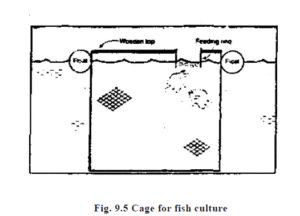
Small cages with mats of locally available plant materials such as palm leaves. Cyperus stem, Phragmites stem and split bamboo are used in India. These cages are of 1 – 2 m2 area. Split bamboos are joined with the help of coir rope or nylon twine. The cages are installed in the water body with bamboo supports at the four comers and the bottom. Materials other than bamboo mats are decayed by the third month and collapsed within a year. Split bamboo cages remain for over a year. Circular cages with thick bamboo stipes tied with nylon twine the durability of over 3 years.
Cages made up of monofilament woven material of 1 – 3 mm mesh size and 0.3 – 1 mm thickness are light and easy to handle, but remain for 6 to 12 months. The exposed part become brittle and gives way. Knotless nylon webbing of 3 – 6 mm mesh size and knotted nylon webbing of 7 -15 mm mesh have been found to be most durable. Cages made of water – proof surface painted light conduit pipe frames with a 10 m2 area are light in weight and have long durability. A battery of cages is enclosed with a bamboo catwalk and the whole structure floated by sealed empty barrels of 200 1. capacity.
The circular cages with conduit pipe structures which can be easily assembled have been designed with nylon webbing in different dimensions. These cages are floated freely on the water surface with the help of 3 – 4 sealed HDPP jerry cans. These arc extremely useful for cage culture. Due to their circular is shape the wave action in minimum. These can be moved from place to place with least water resistance. Due »their circular shape, the rearing space is maximum in side. The aeration and water circulation is better in these cages. Fishes can move in the cages with least obstruction.
Auto-floating, highly durable HDPP pipe frame nylon net cages with 36 m2 area are also used. These are light in weight and not need floats to float on the water surface.
The size of the cages depend on die scale of culture, species cultured, infrastruktur, financial and management resources. The size varies from 2- 10m3 in India, 100 – 150m3 in Indonesia, 60- 180m3 in Kampuchia. 40 – 625 m3 in Vietnam and 30 m3 in Holland. Large cages are operated in Germany with 42 m diameter and 16, 500 m3 at the water depth of 12 m. These are provided with automatic or water jet pump-feeding, special handling and harvesting accessories.
Cal T ura B aku e ikan e S Saya n C usia S NS D T H ei R berhenti C kerabat G
The fishes used for the cage culture should be adaptable to captive culture, fast gro\vng, hardy and disease resistant. The Indian and Chinese carps, tilapia and magur can also be cultured where trash fish is cheaply and abundantly available. In Thailand and Kampuchia the cat fishes, Pangasius species are being cultured in cages successfully. Koi and Singhi are also cultured in India in cages.
Di India, the nursery cages are stocked with carp fry at the range of 150-700 fry/in2 in caaes with different materials. In Japan 15.000-62.000 fry/nr2 of grass carp fry are stocked in nursery cages. The common carp stocking density is 150/nr2 in Kampuchia, 133 -417/nv1 in Indonesia and 80 – 360/nr2 in Vietnam. In Thailand Pangasius sutchi, P. larmmdi dan P. micronemus fry are stocked at densities of 150-300/ nr2 in cages of size 1-10 m2 area with a depth of 1.5m. .
The number of fish that can be stocked in a cage is variable and depends on the canying capacity of the water area, water quality and rate of circulation, the fish species, the quality and quantity of feed supplied. A safe level may be about 3000 to 6000 fish/ ha. In able – fish rearing cages in India, the fingerlings of carps are stocked at density of 30 – 38no /m2 . The tilapia, Oreochromis mossambicus can be stocked a rate of 100 – 200 m-2. Murrels can be stocked at density of 40-100m2.
ibu n ag e laki-laki T NS D kamu Saya el D
The cage culture can be taken up in two phases – nursery phase and table – fish rearing phase. In nursery phase of cage culture, the spawn or fry are reared to fingerling stage in 2-3 months. Different feeds can be used for culture in nursery cages. Groundnut oil cake, dedak beras, egg yolk, soyabean cake, soyamilk and soya flour are used as food for fry in nursery cages. The silkworm pupae are also tried as supplementary food.
The initial size of fish to be stocked in the cages will depend primarily on the length of the growing season and the desired size at harvest. The carp fingerlings for stocking in 16-20 mm mesh cages should be over 10 gr. to expect a final size of over 500 gr. within 6 months. It should be ensured that the fingerlings used for stocking are healthy and disease free. All the fish should be actively moving. It is ideal to stock cages in the cool part of the day.
Di India, the growing season is almost year round, except for December – January in northern parts, where the temperature is low during these winter months. Very little natural food such as plankton, insects and various other organisms enter the cages and is available to fish. Namun, supplementary feeding is essential in the cage culture to get high production. The types of feed used will depend on the species cultured and their prevailing market prices. Murrel, Misalnya, require to be fed with fish, shrimps or other animal matter. Most of the fish cultured are omnivorous and they accept both plant and animal byproducts such as oilcakes, brans, fish meal and silk worm pupae.
Cage fish are generally fed at least once daily throughout the growing period to get better growth. The quantity of feed to be given is important, since under-feeding will reduce growth and production, while over-feeding will waste costly feed and can affect the water quality. A method used to estimate the daily feed to be give in cages is based on the total weight of the fish. The feed is usually expressed on percentage of body weight. In carps, the feeding rate is 4 – 5 % of the body weight per day until they attain approximately 100 gr. And thereafter at 2 – 3 %.
In table-fish rearing phase, involving the high-tech system of saturated stocking and feeding on enriched formulated feeds, the production recorded in common carp is 25 – 35 Kg m° month’1 in foreign countries. The channel catfish, Lactarius punctatus in USA yielded a production of 20 – 35 Kg/nr3. Di Afrika, tilapia yielded 17 Kg/nr3and trout produced 15 Kg/nr3. The food quotient in these cultures varied from 1.3 – 2.1. Di India, a production of 1.5 – 2.5 Kg nr:month’1 common carp was achieved with mixed feed of silk worm pupae, ground cake and rice bran. Catla yielded 1.4 - 2.7 Kg nr2 month’1 with groundnut cake and rice bran with the food quotient 5.6. Tilapia produced 1 – 1.6 Kg nr2 month’1 with a mixture of rice bran, groundnut cake and commercial cattle feed and food quotient ranged from 1.8- 2.3 . About 1 Kg nr2 month”’ of murrel and 0.3 – 1.5 Kg nr2 month’1 of catfishes, singhi and Koi are obtained.
Ca G e cu aku tu ulang Hai F pra A wn S
The freshwater and marine prawns are also cultured in cages. The cages are stocked with wild or hatchery reared post larvae. Commercial scale rearing of post larvae in floating and fixed nursery cages (3.7 X 2.7 X 1.3 m) has been done with considerable success. They are fabricated from fine mesh (0.5 mm) nylon netting, supported by bamboo poles which are driven into the bottom of the water body. The optimal stocking density reported is 30, 000 post larvae/cage (2 .310 m’3). Feed is provided in trays fixed inside the cages. Mulanya, the post larvae are fed on a paste of finely ground trash fish, later are fed with fresh mussel meat.
Pe n budaya R e
Recent results in the use of cages, pens or enclosures and recirculating water systems suggest some ways of compact intensification of production in aquaculture given the accessory inputs. This practice may provide great possibilities in the future in certain selected and suitable areas.
Aquaculture in open waters through the use of pens or enclosures is also a means of minimising the limiting effect of metabolities and pollutants on cultivated stock. Greater production in very limited space has been found possible under those situations. Production figures from these types of aquaculture environments approximates to 4 -10 t/ha/yr in Laguna lake in Philippines.
Se aku ectio n Hai F S itu S FO R pe n budaya ulang
i) Low tidal amplitude
ii) Fish pen – site must be sheltered as much as possible against high winds
iii) Depth not less than 1 meter during lowest water level
iv) The best site is on the leeward side of the prevailing winds with moderate flow of current especially in a place where current in overturning
v) Water with stable PH slight variation is best. Avoid turbid and polluted water.
vi) Muddy clay and clay – loam soils are best types of bottom soil. Too much still and decomposing organic matter must be avoided.
C ons T ruc T io n Hai F P en S
Pens can be constructed with the help of bamboo screens and nets
A . Bersama n stru C tio n Hai F P e n S w Saya T H B A mbo Hai scre e n S
Split bamboo should not necessarily be shaped and rounded. They are soaked in water for two weeks and then dried for one week. During the soaking and drying period, bamboo poles are prepared and staked at the chosen site according to thedesired size and shape of the fish pen. After stacking poles, bamboo splits are closely woven extending to a length of more or less five meters and made into a roll. After weaving, these are set by stretching them from one pole to the other interrurned or just set inside or outside close to the poles from bottom to top. They are tied every pole by rubber and one provided with sliced rubber around, liming one on top and one at the bottom. These splitted rubber prevent them from wear due to wave action. Nursery nets which should be 1/16 th to 1/10 th of the area of the fish pen can be set before constructing the fish pen or after it is set.
B C pada S tr kamu cti Hai n Hai F P e n wi T H n et S
Construction of a fish pen made out of synthetic netting is easier than one made of bamboo screens. Netting materials can be kuralon, nylon, cremona, tamsi. etc. An ordinary fisherman can connect the nets into the fish.pen after taking into account the desired height or depth of the pen site. After the net is constructed , the poles are staked in mud after making a provision for the front rope and tie rope at the interval of 1.0 – 2.0 m per stake and also the provision for float rope. In preparing the poles, all nodes are cleaned except one node with brunch protending one inch which is staked in the mud from 15 – 30 cm or more depending upon the depth of soft mud. With this node the foot rope is tied, and these together with the bottom net are staked in the mud. Boulders can be used as sinkers in the absence of lead sinkers. Bamboo tips of 1-1 Vi m are also used to stake the bottom net with a foot rope firm into the mud to avoid escape of the fish stock. Construction of the nursery net may be done before or after the construction of the fish pen. They should have a free board of about 1 meter above the normal water level to prevent entry or exit of fishes by jumping and as a precaution against water level fluctuations. Metal and metal coated with HDPP screens are often used for pens which is highly durable.
Cu aku tu ulang
Pen culture is extensively practiced in Japan, Peru and Philippines. Fish formers in Laguna debay and Sansabo Kekes stock milk fish fingerlings in pens and grow them to marketable size (200 g or above). Prawn are also similarly cultured. Very little work has been done on pen culture of fishes in India.
Traditional trapping and extensive culture of tiger prawn, milk fish, pearl spot, mullet, bekti and thread fins are done in some sort of pens and enclosures in canals joining the backwaters in Kerala and in the shallow areas of Chilka lake (Janos) in Orissa. The pens are made by weaving split bamboo or with netting. The enclosing of fishes is done usually after the monsoon season upto late autumn and the culture period lasts for about 6 to 8 months. The size of Janos in the Chilka lake varies from 5 to 500 ha. Since the stocking and harvesting are not done systematically, precise production S3* figures areajatavailable. The yield, Namun, is estimated to be about 60 Kg/ha/season.Seed rearing experiments were conducted in a split bamboo enclosure of 247.5 m2 reinforced with a nylon netting in Punarswamy Bhavanisagar (Tamilnadu). It was stocked with mrigal (size 7 mm) and Labeo fimbratus (size 5 mm) spawn at the rate of 4.6 million/ha and usual farm practices were followed. In 30 days mrigal attained a size of 38 mm and fimbriatus, 28 mm. At the time of conclusion of the study after 3 months, the former had attained a size of 88 mm and the later 75 mm. The overall survival obtained was 27.8 %.
Major carp seed rearing in pens is being done every year from 1982 onwards in the Tungabhadra reservoir in Karnataka. A shallow bay of the reservoir near Hampusagara is cordoned off with bamboo mats reinforced with Casuarina poles and lined with mononlament cloth during the summer months, prior to the reservoir getting filled. The pen is divided into several compartments with bamboo mats, lined with mononlament cloth. When the nursery pen, get water with the filling of reservoir, they are stocked with spawn of carps. The stocking density varies from 5 to 20 million spawn ha. The feed given is a mixture of ground nut cake and rice bran (1 :1). After 2 to 4 months the fingerlings
are enumerated and released in the reservoir. A bertahan hidup varying from 11 to 30 % is obtained from the varies nursery pens.
A pen culture experiment for raising cattle and rohu in Mamkamaun a flood plain lake in Gandak basic yields a computed production of 4/ ha/6 months. The experiment was conducted in a bamboo screen pen (1000m) and the stock was fed with a mixture of nee bran and mustard cake, apart from a feed formulated from the aquatic weeds collected from the lake. Since intrusion of fishes from outside including predators is possible in pens. It is important to stock larger fingerlings (over 50 g size) to ensure better survival. It is be desirable to have scale pen culture. The species mix and stocking rates will mainly depend on the natural food supply, supplemental feeding strategy, water depth and the duration of rearing.
Sup P lem e tidak R kamu F e edi n G
The fish pens that are densely stocked with 10-20 fish per square meter, generally need regular feeding at the rate of 4 -10 % of the total body weight of the stock at least once 3 week, or it could be divided into daily feeding. The amount of food to be given depends on the condition of the culture fish which could be checked through sampling at least once a month.
Managemen T
Management offish pens is more laborious and demanding than a fish farm, because there are more risks in managing fish pens. Fingerlings are liable to escape once a single bamboo split breaks or a small portion of the net is torn. Every now and then the fish pens have to be checked for any holes or breaks.
The fish pen site has to be laid idle at least one month a year so that excess food and other organic matter are completely decomposed before stocking with new fingerlings. If the site is not sheltered it would be advisable to remove the net or split bamboo screen during the stormy season and repeat during fine weather condition.
S um M ar kamu
The culturable species of air breathing fishes are Fig. 9.1
C H A nn A S T R A dia kamu s – Big or striped murrel or snake head fish
C hann A punctatu s – Spotted murrel
Channa marulius – Giant murrel
Clarias batrachus – Magur
Heteropneustes fossilis – Singhi
Anabas testudineus – Koi or climbing perch.
Many species of trout are grown, but the three most common of them are the rainbow trout, Slamo gairdneri atau Oncorynchus mykiss, the Eurorean brown trout, S.trutta (Fig. 9.2)and the brook trout, Salvelinus fontinalis. Trouts have a streamlined body, narrow gill openings and reduced gills. Trouts are adapted to highly oxygenated waters and freezing point temperatures. Trouts have great power of locomotion with clinging and burrowing habits. Mouth is modified with rasping lips for food collection from pebbles, rocks, dll..
Sewage is a cloudy, dirty and odorous fluid from our toilets and kitchens of our houses. It has minerals and organic nutrients in a dissolved state or dispersed in a solid condition. Disposal of sewage has become a global problem because of urbanization. It is an effect of demophora, i.e. an unabated growth of human population. Dalam beberapa tahun terakhir, sewage has become a major pollutant of inland waters, especially rivers. It is a source of many epidemics. It is responsible for a serious threat to soil and water ecosystems. The approach towards waste water disposal should be utilization of this residue with the concept of their reuse or recycle through an ecologically balanced system involving mainly aquaculture. The utility of sewage effluent to enhance fertility of freshwater ponds has long been known in many countries of the world.
In our country, especially in rural areas, mere has been a tremendous growth of biogas plants as a source of non-conventional energy. Biogas is also called as gober gas. The biogas plant is a device for conversion of fermentable organic matter, especially cattle dung into combustible gas and fully matured organic manure or slurry by anaerobic fermentation. The nutrients of the generated slurry can be harvested for production of feed and food and replace conventional inorganic fertilizers. Biogas slurry enhances fish production.










